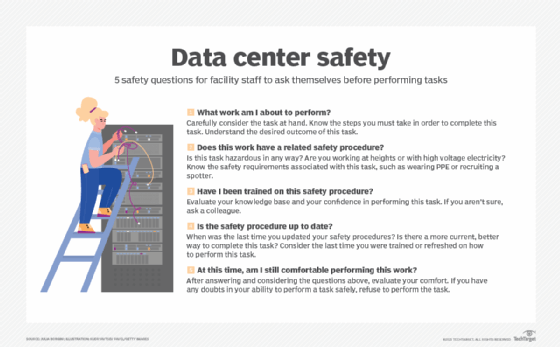
Getty Images/iStockphoto
ISO 14644 standards: Cleanroom guidelines for data centers
There are regulated requirements to maintain data center equipment and functionality. ISO 14644 cleanroom standards lay out guidelines to keep data centers clean.
Cleanrooms and high-filtration systems are essential to industries that must filter airborne pollutants.
The ISO standard 14644 series enables organizations to maintain cleanrooms and air hygiene for air-controlled environments like data centers. While data centers do not need to adhere to all parts of the ISO 14644 standards, many are relevant. The standard and related series outline everything from particle concentration classification to air testing methods and designs.
This article explains the importance of ISO 14644 standards in a data center environment and includes details on parts 1 through 14 and 18. Follow the requirements of ISO 14644 standards to ensure data centers function at a high level and maintain operations and equipment.
A brief history of ISO 14644
The ISO 14644 series has become the international benchmark for cleanroom practices. It replaces outdated systems like Federal Standard 209E in the U.S. and harmonizes global requirements into a unified standard. Unlike national or application-specific regulations, ISO standards apply across industries, making them ideal for multinational operations that maintain consistent cleanliness and compliance across multiple regions and product lines.
ISO 14644 evolves with industries. In 2001, this standard was only one part. ISO 14644 then grew to four parts in 2015, 10 parts in 2019 and over 20 parts in 2023 -- which was revised in 2025. To keep the standard relevant, experts in the field update previous parts and add new ones when necessary. The latest version covers design, airborne particle sampling techniques, separative devices and energy efficiency.
Why ISO 14644 matters in data center environments
Data centers require controlled environments to protect IT equipment from contamination that can cause failures, reduce performance or shorten equipment lifespan. Airborne particles, chemical contaminants and surface contamination affect critical IT infrastructure.
The ISO 14644 standards provide a framework for compliance requirements, energy efficiency, equipment protection, operational reliability and risk management.
- Compliance requirements. Meets industry regulations and customer expectations for data center operations.
- Energy efficiency. Implements controlled environmental practices that optimize HVAC and filtration systems.
- Equipment protection. Prevents particle contamination that can damage servers, storage systems and networking equipment.
- Operational reliability. Maintains consistent environmental conditions to ensure optimal equipment performance.
- Risk management. Reduces the likelihood of contamination-related downtime and equipment failures.
Parts of ISO 14644 for data centers
While ISO 14644 contains over 20 parts relevant to situations where controlled environments are necessary, this section focuses on Parts 1 through 14 and Part 18.
Parts 14644-6 and 14644-11 are not included as Part 6 was withdrawn by ISO/TC 209, and Part 11 does not exist.
Part 14644-1: Classification of air cleanliness by particle concentration
Part 14644-1 specifies the classification of air cleanliness by airborne particle concentrations in cleanrooms and clean zones, as well as for separative devices as defined in ISO 14644-7. It outlines the classification for environmental cleanliness in data centers from Classes 1 to 9.
ISO Class 1 environments are the cleanest, like those in silicon chip clean rooms. Classes 7 and 8 are the most appropriate for IT facilities like data centers and server rooms.
Part 14644-2: Monitoring to provide evidence of cleanroom performance related to air cleanliness by particle concentration
Part 14644-2 specifies the monitoring and testing requirements for cleanrooms and clean zones. It outlines the minimum requirements for a monitoring plan based on parameters that measure or affect airborne particle concentration.
To meet this requirement, data centers must use sequential, continuous or periodic air monitoring. For example, with periodic monitoring, the facility must specify the test frequency when proving compliance with the standard.
Part 14644-3: Test methods
Part 14644-3 specifies the test methods that support the operation of the controlled environment to meet the relevant air cleanliness classification, attributes and related conditions.
Test methods depend on the controlled environment's airflow characteristics and occupancy states. Data centers fulfill multiple airflow and occupancy states at various times. Operators should read this standard carefully to ensure they are compliant.
This ISO standard has not been approved as an American National Standard.
Part 14644-4: Design, construction and start-up
Part 14644-4 specifies creating a cleanroom or controlled environment from design, construction and startup. It applies to new, refurbished and modified installations but does not prescribe specific technologies or methods to achieve the requirements. Each location can use any method, technology, mechanic and design to meet the standard.
Data center builders, maintainers and owners can use the ISO 14644 checklist to ensure satisfactory operation for the entire lifecycle of the data center or controlled environment.
Part 14644-5: Operations
Part 14644-5 specifies the basic cleanroom and controlled environment operations requirements, but it has been significantly updated for 2025. This revision reflects modern cleanroom practices and regulatory expectations, and it strongly relates to Part 18.
The revision of Part 14644-5 specifies requirements for establishing an operations control program to ensure efficient cleanroom operation within specified cleanliness levels. The OCP includes personnel management, personnel and material entry and exit, cleaning, maintenance and monitoring.
The updated standard provides a system that specifies policies and operational procedures for maintaining cleanliness levels, training of personnel, and maintaining a comprehensive personnel management program. Data center operators should review this updated standard to ensure compliance with their operational systems, personnel rules, equipment and cleaning schedules.
This only applies to contamination control and does not include aspects of national, local and industry-related safety regulations.

Part 14644-7: Separative devices (clean air hoods, gloveboxes, isolators and mini environments)
Part 14644-7 specifies the minimum requirements for the separative devices used in controlled spaces. It outlines the approval, construction, design, installation and testing of the devices used in cleanrooms and other controlled environments, like data centers.
Data center operators should review this standard to ensure they use the relevant devices that help them conform to the standard.
This part does not include requirements by national, local and industry-related safety regulations, such as fire.
Part 14644-8: Assessment of air cleanliness for chemical concentration
Part 14644-8 establishes the assessment processes for grading air chemical cleanliness levels in controlled environments according to specific concentration categories: individual, group or category. It provides a protocol for testing methods, analysis and time-weighted factors that affect determination.
This part does not apply to industries, processes or productions not put at risk by the presence of air chemical cleanliness. This means it might apply to data centers, depending on the equipment, location and workloads it handles.
Part 14644-9: Assessment of surface cleanliness for particle concentration
Part 14644-9 establishes a particle cleanliness level assessment for solid surfaces in controlled environments. It applies to all solid surfaces in the controlled environment, such as walls, ceilings, floors, equipment and tools.
Data center operators should pay attention to this standard to ensure their facilities and operations meet it.
This part does not outline cleanliness requirements or surface suitability for specific industries, processes or procedures. It also does not consider material characteristics for items within the controlled environment.
Part 14644-10: Assessment of surface cleanliness for chemical contamination
Part 14644-10 establishes the cleanliness testing processes of surfaces that contain chemical compounds or elements. It also applies to all solid surfaces in the controlled environment, such as walls, ceilings, floors, equipment and tools.
This part would generally only apply to data centers located close to production or manufacturing facilities, but organizations should monitor it for each data center location as a precaution.
This part does not include aspects of national, local and industry-related safety regulations that must be under observation in the controlled environment.
Part 14644-12: Specifications for monitoring air cleanliness by nanoscale particle concentration
Part 14644-12 covers how to monitor the air cleanliness of airborne nanoscale particles. It covers particles with a lower size limit of 0.1 microns or less and is mainly used in operational facilities.
This part is intended to support nanotechnology research, development and manufacturing. It might not apply to data centers unless they are located near or support these industries.
This part does not include aspects of national, local and industry-related safety regulations that must be under observation in the controlled environment.
Part 14644-13: Cleaning of surfaces to achieve defined levels of cleanliness in terms of particle and chemical classifications
Part 14644-13 offers guidelines for cleaning surfaces -- equipment and material surfaces -- in a controlled environment to a specific degree. It applies to all external or internal surfaces of interest within the environment.
It provides guidelines for assessing cleaning methods that achieve the appropriate cleanliness level and surface cleanliness by chemical concentration class. It also offers techniques that facility operators should consider to achieve these cleanliness levels.
Data center operators and facility managers should refer to their equipment's documentation for more details on processes, methods and products.
Part 14644-14: Assessment of suitability for use of equipment by airborne particle concentration
Part 14644-14 specifies a methodology for classifying air cleanliness by particle concentration to assess the suitability of the equipment.
This applies to data centers and relates to any equipment that people bring, unbox and install in the facility, along with tools and equipment to perform regular activities.
This part does not include aspects of national, local and industry-related safety regulations that must be under observation in the controlled environment.
Part 14644-18: Assessment of suitability of consumables (updated 2025)
Part 14644-18:2023 provides guidance for assessing personal and non-personal consumables for their appropriate use in cleanrooms, clean zones or controlled zones. Guidance is based on product and process requirements, cleanliness attributes and functional performance properties.
ISO 14644-18 complements cleanroom operations as outlined in ISO 14644-5 and provides a structured approach to evaluate cleanroom consumables. For data centers, this applies to cleaning materials, protective equipment, maintenance supplies and other consumable items used in the facility.
Key aspects of Part 14644-18 include:
- Consumable assessment. Evaluates items used for operations in cleanrooms that can be disposed of or repurposed.
- Contamination control. Addresses suitability assessment in respect to contamination in air and on surfaces by particles, chemicals and microorganisms.
- Functional performance. Considers cleanliness attributes and functional performance properties.
- Risk identification. Identifies associated risks with consumable use in controlled environments.
Editor's note: This article was updated in 2025 to reflect the recent changes to the ISO 14644 standards.
Julia Borgini is a freelance technical copywriter, content marketer, content strategist and geek. She writes about B2B tech, SaaS, DevOps, the cloud and other tech topics.
Kelly Richardson is the site editor for TechTarget's data center site.







